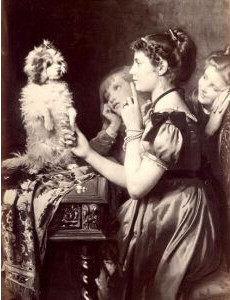The History of the
Miniature Poodle
Disclaimer: Pleasant Meadows has a "broad" watermark placed on our website to keep our images from being stolen. The images on this page were found on Google and Pleasant Meadows takes NO CLAIM to them. The original artists and/or photographers are UNKNOWN and Pleasant Meadows will happily give credit to them if their names and/or companies become known to us.
General: Good natured, spirited, intelligent, and friendly.
Head: The head is proportionate to the size of the dog. When viewed from the side, the skull and muzzle are roughly parallel to one another and joined by a slight but definite stop
Ears: The ears of the Miniature Poodle are long and wide, low set on the head and dangle close to the face.
Muzzle: The Miniature Poodle has a scissor bite.
Eyes: Miniature Poodles have almond shaped, dark eyes that are not set too close together.
Nose: The nose of the Poodle is black or liver, depending on the color of its coat.
Neck: Neck well proportioned and of good length. The Poodles neck is sufficiently strong to allow the head to be carried high when standing or moving. The skin fits tightly on the neck and throat.
Forequarters: The shoulders are well laid back, strong and muscular.
Body: Miniature Poodles have a chest that is deep and reasonably wide. The back of the Poodle is moderately short, strong and slightly hollowed. The loins of the Poodle , loins broad and muscular. The loin is short, broad and muscular with moderate tuck-up. The ribs extend well back and are well sprung out from the spine,
Hindquarters: The thighs of the Poodle are well developed and muscular. The stifles have good curvature, well bent and the hocks are well let down and straight. The Poodles hind legs turn neither in nor out.
Shoulders: Shoulders are smooth and muscled. The Poodles shoulder blades are long and well laid back.
Legs: The Miniature Poodles legs are set straight from shoulders and are well muscled.








The Poodle has been known throughout Western Europe for at least 400 years and is depicted in 15th century paintings and in bas-reliefs from the 1st century. The subject is controversial of where the dog was officially developed and no one really knows the breed’s true country of origin. France has taken a claim on the origin, but the AKC gives the honor to Germany, where they say it was used as a water retrieval dog. Other claims have been Denmark, or the ancient Piedmont. What is certain is that the dog was a descendant of the now extinct French Water Dog, the Barbet and possibly the Hungarian Water Hound. The name "Poodle" most likely came out of the German word "Pudel," which means "one who plays in water." The "Poodle clip" was designed by hunters to help the dogs swim more efficiently. They would leave hair on the leg joints to protect them from extreme cold and sharp reeds. Hunters in Germany and France used the Poodle as a gundog and as a retriever of waterfowl and to sniff out truffles lying underground in the woods. The French started using the breed as a circus performer because of the dog's high intelligence and trainability. The breed became very popular in France, which led to the common name "French Poodle," but the French people actually called the breed the "Caniche," meaning "duck dog.” The Toy and Miniature Poodle varieties were bred down from larger dogs, today known as Standard Poodles. In the 18th century, smaller Poodles became popular with royal people. The three official sizes are the Toy, Miniature and Standard Poodle. They are considered one breed and are judged by the same written standard but with different size requirements. Breeders are also breeding an in-between size called a Klein Poodle (Moyen Poodle) and a smaller Teacup Poodle.




Just like people, dogs are prone to certain conditions. Here are a few of the most common found in the Miniature Poodle:
Progressive Retinal Atrophy(PRA) — This is a genetic eye disorder which progresses gradually, resulting in blindness. Two dogs that are PRA cleared can be bred to any dog and have an extremely low chance of PRA showing up in their puppies. To read more about PRA click here!
Patella Sub-luxation — This occurs when the kneecap pops in and out of the groove where it should be held in place by ligaments. A dog with this problem can often be seen to be favouring one of its back legs until the kneecap pops back into place. This problem can be surgically corrected.
Epilepsy — Seizures can occur in all three sizes of poodle and the most common cause is idiopathic epilepsy which is an inherited form of epilepsy. However, many factors can cause seizures besides idiopathic epilepsy and it is very important to have the poodle diagnosed if seizures begin.
Hypothyroidism — This is a condition resulting from an inadequate production of thyroid hormone and treated with medication. Symptoms include lethargy, obesity, excessive hunger, a coarse coat texture. Testing for thyroid malfunction is done through blood sample.







